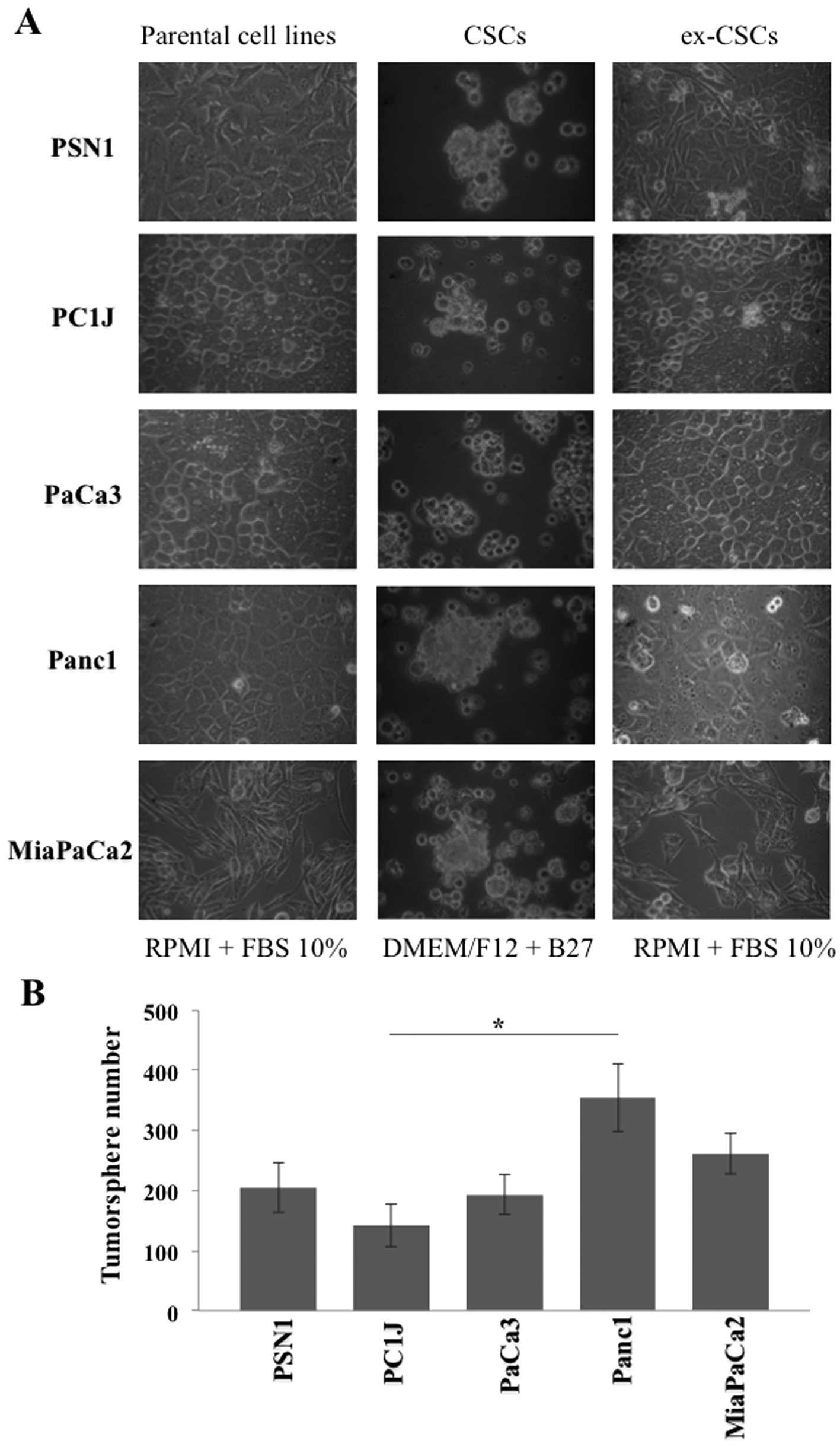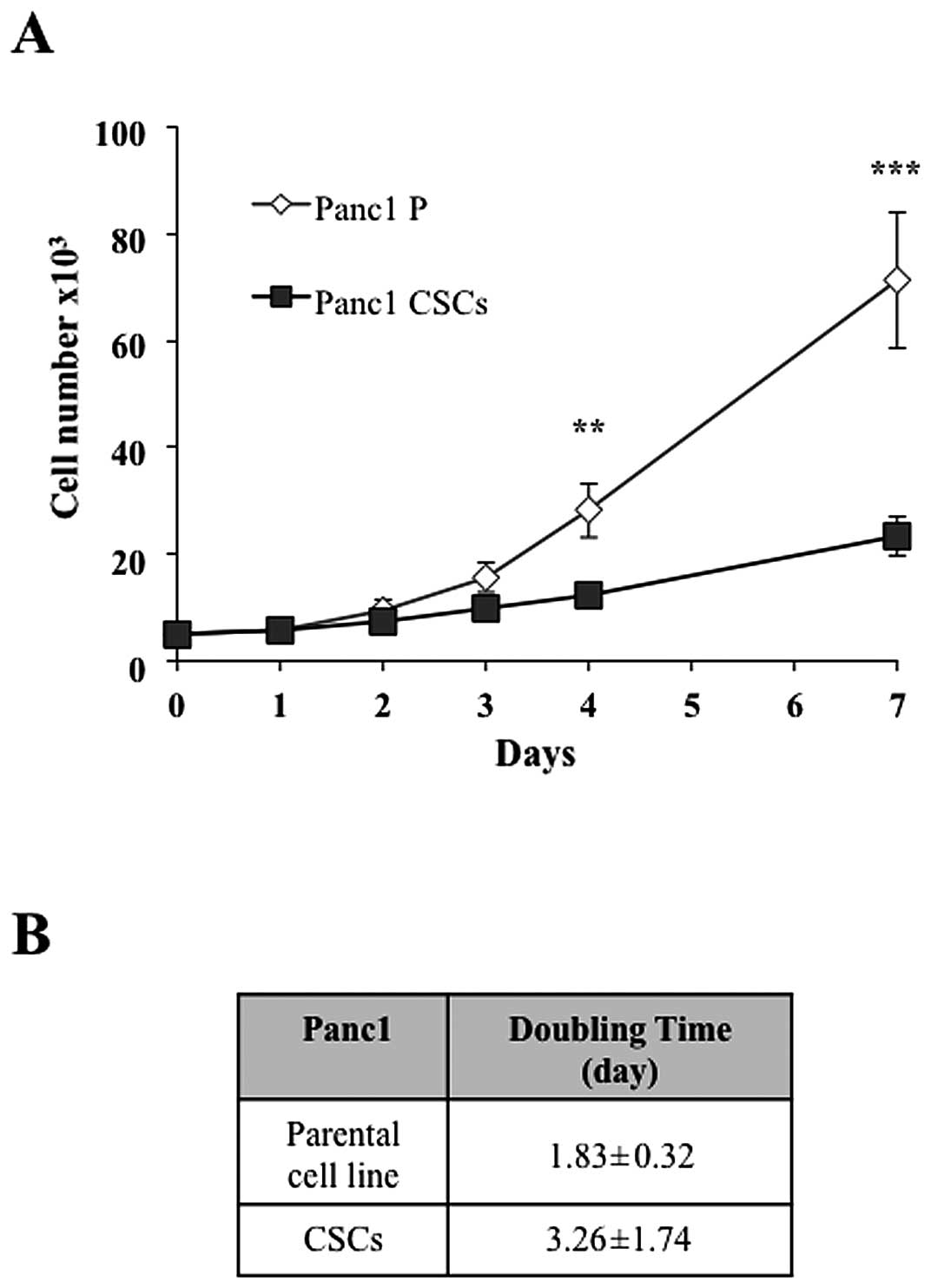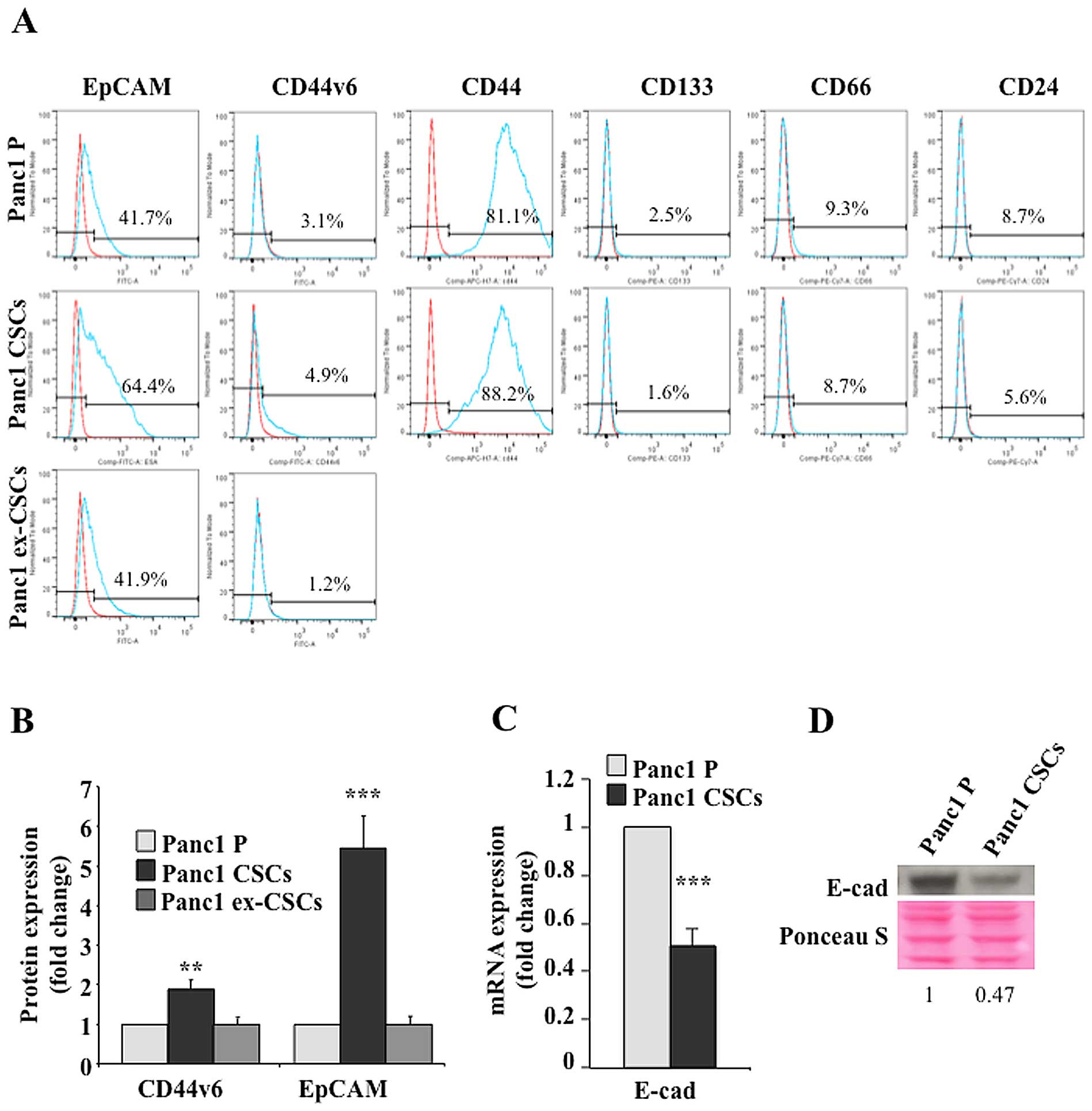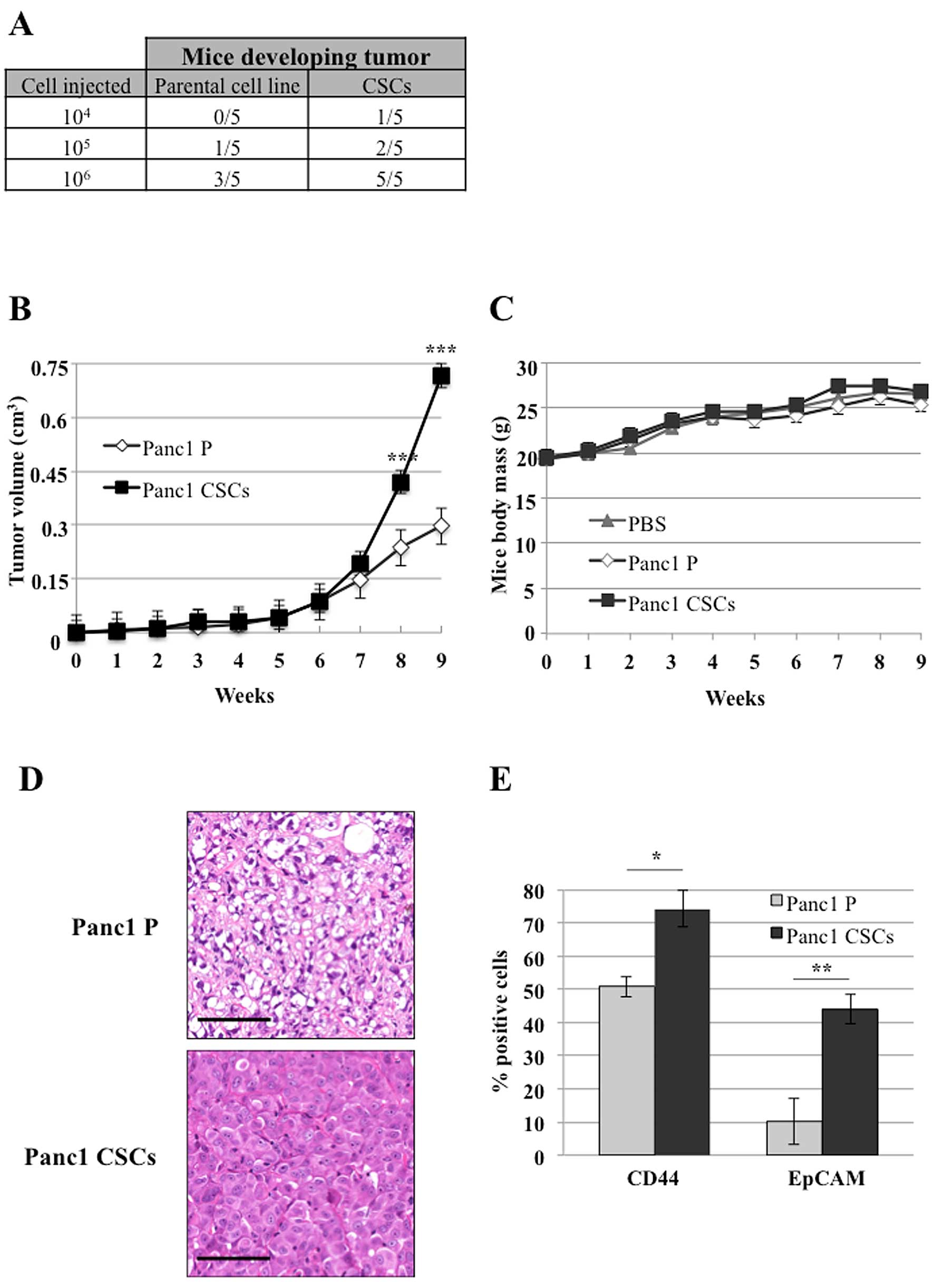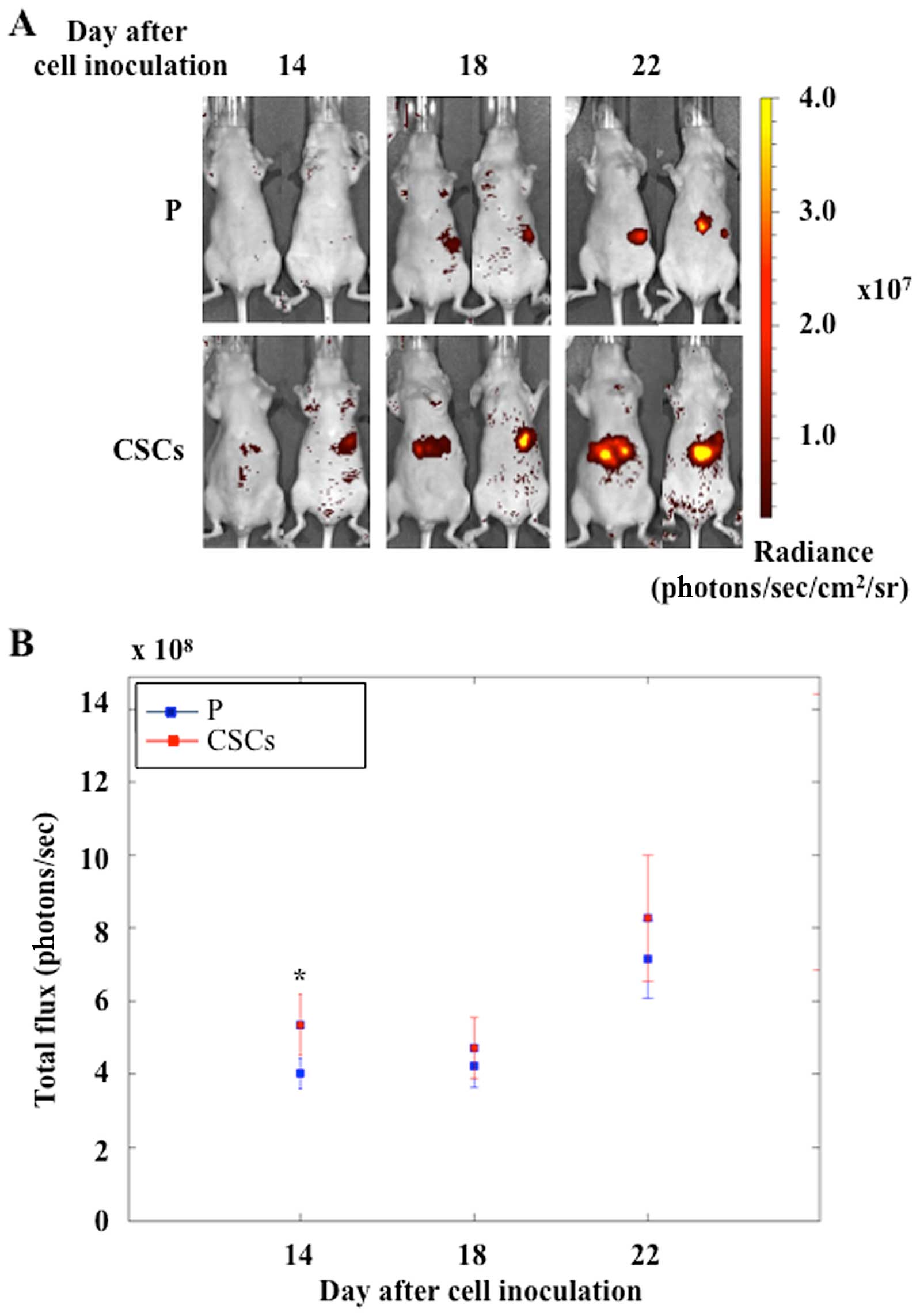|
1
|
Bünger S, Barow M, Thorns C, et al:
Pancreatic carcinoma cell lines reflect frequency and variability
of cancer stem cell markers in clinical tissue. Eur Surg Res.
49:88–98. 2012. View Article : Google Scholar : PubMed/NCBI
|
|
2
|
Rasheed ZA and Matsui W: Biological and
clinical relevance of stem cells in pancreatic adenocarcinoma. J
Gastroenterol Hepatol. 27(Suppl 2): S15–S18. 2012. View Article : Google Scholar
|
|
3
|
Marjanovic ND, Weinberg RA and Chaffer CL:
Cell plasticity and heterogeneity in cancer. Clin Chem. 59:168–179.
2013. View Article : Google Scholar
|
|
4
|
Bonnet D and Dick JE: Human acute myeloid
leukemia is organized as a hierarchy that originates from a
primitive hematopoietic cell. Nat Med. 3:730–737. 1997. View Article : Google Scholar : PubMed/NCBI
|
|
5
|
Gaviraghi M, Tunici P, Valensin S, et al:
Pancreatic cancer spheres are more than just aggregates of stem
marker-positive cells. Biosci Rep. 31:45–55. 2011. View Article : Google Scholar
|
|
6
|
Kure S, Matsuda Y, Hagio M, Ueda J, Naito
Z and Ishiwata T: Expression of cancer stem cell markers in
pancreatic intraepithelial neoplasias and pancreatic ductal
adenocarcinomas. Int J Oncol. 41:1314–1324. 2012.PubMed/NCBI
|
|
7
|
Rhim AD, Mirek ET, Aiello NM, et al: EMT
and dissemination precede pancreatic tumor formation. Cell.
148:349–361. 2012. View Article : Google Scholar : PubMed/NCBI
|
|
8
|
Yang G, Quan Y, Wang W, et al: Dynamic
equilibrium between cancer stem cells and non-stem cancer cells in
human SW620 and MCF-7 cancer cell populations. Br J Cancer.
106:1512–1519. 2012. View Article : Google Scholar : PubMed/NCBI
|
|
9
|
Dean M, Fojo T and Bates S: Tumour stem
cells and drug resistance. Nat Rev Cancer. 5:275–284. 2005.
View Article : Google Scholar : PubMed/NCBI
|
|
10
|
Feng Y, Dai X, Li X, et al: EGF signalling
pathway regulates colon cancer stem cell proliferation and
apoptosis. Cell Prolif. 45:413–419. 2012. View Article : Google Scholar : PubMed/NCBI
|
|
11
|
Ponti D, Costa A, Zaffaroni N, et al:
Isolation and in vitro propagation of tumorigenic breast cancer
cells with stem/progenitor cell properties. Cancer Res.
65:5506–5511. 2005. View Article : Google Scholar : PubMed/NCBI
|
|
12
|
Tsai LL, Yu CC, Chang YC, Yu CH and Chou
MY: Markedly increased Oct4 and Nanog expression correlates with
cisplatin resistance in oral squamous cell carcinoma. J Oral Pathol
Med. 40:621–628. 2011. View Article : Google Scholar : PubMed/NCBI
|
|
13
|
Chaffer CL, Brueckmann I, Scheel C, et al:
Normal and neoplastic nonstem cells can spontaneously convert to a
stem-like state. Proc Natl Acad Sci USA. 108:7950–7955. 2011.
View Article : Google Scholar : PubMed/NCBI
|
|
14
|
Varga J, De Oliveira T and Greten FR: The
architect who never sleeps: tumor-induced plasticity. FEBS Lett.
588:2422–2427. 2014. View Article : Google Scholar : PubMed/NCBI
|
|
15
|
Melisi D, Ishiyama S, Sclabas GM, et al:
LY2109761, a novel transforming growth factor beta receptor type I
and type II dual inhibitor, as a therapeutic approach to
suppressing pancreatic cancer metastasis. Mol Cancer Ther.
7:829–840. 2008. View Article : Google Scholar : PubMed/NCBI
|
|
16
|
Zheng G, Lyons JG, Tan TK, et al:
Disruption of E-cadherin by matrix metalloproteinase directly
mediates epithelial-mesenchymal transition downstream of
transforming growth factor-beta1 in renal tubular epithelial cells.
Am J Pathol. 175:580–591. 2009. View Article : Google Scholar : PubMed/NCBI
|
|
17
|
Chen SF, Chang YC, Nieh S, Liu CL, Yang CY
and Lin YS: Nonadhesive culture system as a model of rapid sphere
formation with cancer stem cell properties. PLoS One. 7:e318642012.
View Article : Google Scholar : PubMed/NCBI
|
|
18
|
Vaz AP, Ponnusamy MP, Rachagani S, Dey P,
Ganti AK and Batra SK: Novel role of pancreatic differentiation 2
in facilitating self-renewal and drug resistance of pancreatic
cancer stem cells. Br J Cancer. 111:486–496. 2014. View Article : Google Scholar : PubMed/NCBI
|
|
19
|
Shackleton M: Normal stem cells and cancer
stem cells: similar and different. Semin Cancer Biol. 20:85–92.
2010. View Article : Google Scholar : PubMed/NCBI
|
|
20
|
Singh AK, Arya RK, Maheshwari S, et al:
Tumor heterogeneity and cancer stem cell paradigm: updates in
concept, controversies and clinical relevance. Int J Cancer. Feb
22–2014.(Epub ahead of print). View Article : Google Scholar
|
|
21
|
Song J, Chang I, Chen Z, Kang M and Wang
CY: Characterization of side populations in HNSCC: highly invasive,
chemoresistant and abnormal Wnt signaling. PLoS One. 5:e114562010.
View Article : Google Scholar : PubMed/NCBI
|
|
22
|
Yanamoto S, Kawasaki G, Yamada S, et al:
Isolation and characterization of cancer stem-like side population
cells in human oral cancer cells. Oral Oncol. 47:855–860. 2011.
View Article : Google Scholar : PubMed/NCBI
|
|
23
|
Shah AN, Summy JM, Zhang J, Park SI,
Parikh NU and Gallick GE: Development and characterization of
gemcitabine-resistant pancreatic tumor cells. Ann Surg Oncol.
14:3629–3637. 2007. View Article : Google Scholar : PubMed/NCBI
|
|
24
|
Zeng W, Chen X, Ma Y, et al: A novel
approach for enriching cancer stem cells from the human SW-13
adrenocortical carcinoma cell line. Anticancer Res. 34:117–123.
2014.PubMed/NCBI
|
|
25
|
Donadelli M, Costanzo C, Beghelli S, et
al: Synergistic inhibition of pancreatic adenocarcinoma cell growth
by trichostatin A and gemcitabine. Biochim Biophys Acta.
1773:1095–1106. 2007. View Article : Google Scholar : PubMed/NCBI
|
|
26
|
Piacentini P, Donadelli M, Costanzo C,
Moore PS, Palmieri M and Scarpa A: Trichostatin A enhances the
response of chemotherapeutic agents in inhibiting pancreatic cancer
cell proliferation. Virchows Arch. 448:797–804. 2006. View Article : Google Scholar : PubMed/NCBI
|
|
27
|
Moore PS, Sipos B, Orlandini S, et al:
Genetic profile of 22 pancreatic carcinoma cell lines. Analysis of
K-ras, p53, p16 and DPC4/Smad4. Virchows Arch. 439:798–802. 2001.
View Article : Google Scholar
|
|
28
|
Niess H, Camaj P, Renner A, et al: Side
population cells of pancreatic cancer show characteristics of
cancer stem cells responsible for resistance and metastasis. Target
Oncol. Jun 22–2014.(Epub ahead of print). View Article : Google Scholar : PubMed/NCBI
|
|
29
|
Li C, Heidt DG, Dalerba P, et al:
Identification of pancreatic cancer stem cells. Cancer Res.
67:1030–1037. 2007. View Article : Google Scholar : PubMed/NCBI
|
|
30
|
Gemei M, Mirabelli P, Di Noto R, et al:
CD66c is a novel marker for colorectal cancer stem cell isolation,
and its silencing halts tumor growth in vivo. Cancer. 119:729–738.
2013. View Article : Google Scholar
|
|
31
|
Hermann PC, Huber SL, Herrler T, et al:
Distinct populations of cancer stem cells determine tumor growth
and metastatic activity in human pancreatic cancer. Cell Stem Cell.
1:313–323. 2007. View Article : Google Scholar
|
|
32
|
Arpicco S, Lerda C, Dalla Pozza E, et al:
Hyaluronic acid-coated liposomes for active targeting of
gemcitabine. Eur J Pharm Biopharm. 85:373–380. 2013. View Article : Google Scholar : PubMed/NCBI
|
|
33
|
Cain JW, Hauptschein RS, Stewart JK, Bagci
T, Sahagian GG and Jay DG: Identification of CD44 as a surface
biomarker for drug resistance by surface proteome signature
technology. Mol Cancer Res. 9:637–647. 2011. View Article : Google Scholar : PubMed/NCBI
|















